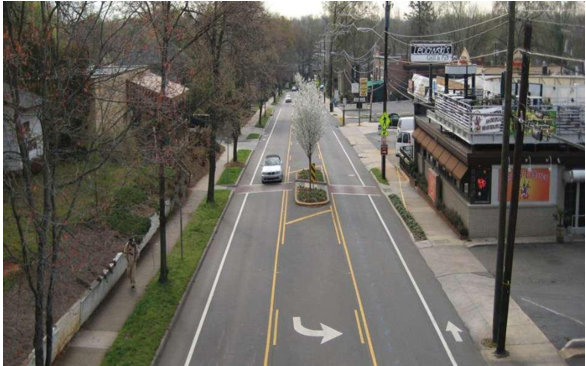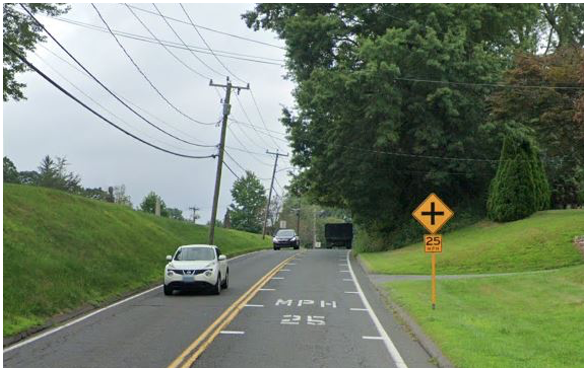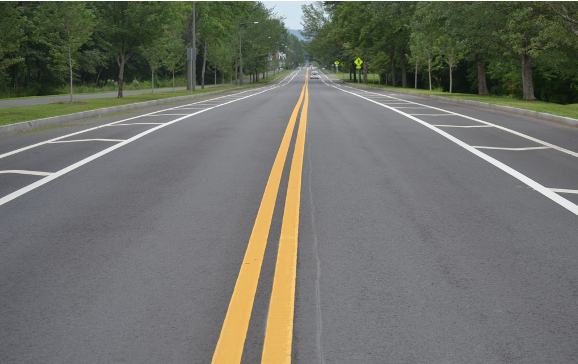Roadway configuration, along with visual cues for drivers, plays an important role in maintaining safe speeds and promoting traffic safety.
Features
| Road diets | Optical measures | Lane markings |
|---|---|---|
| Narrowing or eliminating travel lanes on your roadways by installing road diets can help to calm traffic speeds. | Visual cues can help focus drivers’ attention on their speed and draw their attention to the need to reduce speed for safety. | Marked lanes can provide various benefits, such as reducing travel-lane width, or separating opposing traffic through target areas. |
Costs & considerations
| Feature | Estimated cost | Percent speed reduction |
|---|---|---|
| Road diet restriping | $25,000-$40,000; geometric features increase cost significantly | 4-9% |
| Optical markings | Low-cost and easy to install; actual costs vary | 0-27% |
*Note: Estimates are based on past projects and commonly used materials, and may vary depending on roadway condition, location, time, and other factors. The speed reduction percentages were sourced from FHWA's Engineering Speed Management Countermeasures Table linked in the resources below.
When considering cost, it is helpful to keep in mind potential return on investment in terms of enhanced safety. A study of rural highways in Kansas showed that edge lines would yield benefits exceeding their costs if an average of one non-intersection crash occurs annually every 15.5 miles of roadway.
Potential speed benefits
Road diets and marking measures have been found to effectively reduce the speed most people drive on a road. In one analysis, lateral shifts were found to reduce the 85th percentile speed by 25 percent on rural roads. The benefits of adding a centerline, in combination with existing edge lines, include low-cost, flexibility, and ease of implementation. (FHWA Speed Management Toolkit: Table 4)
These measures can also offer additional safety benefits and flexibility in terms of implementation. A pilot road diet was implemented in the town of Hingham, MA using flexible plastic delineator posts due to concerns around permanent lane elimination. Upon discovering speeds reduced as much as 5mph during the pilot, the town decided to implement a permanent road diet. After the pilot, it was also found that traffic and congestion was not increased as anticipated, contributing to their decision to make the road diet a permanent fixture (MassDOT).
Previous studies on centerlines have shown them to reduce crash frequency by 27 percent, and an FHWA Road Diet Study in Iowa found a 25 percent reduction in crashes per mile of roadway associated with a road diet and a 19 percent reduction in the overall crash rate. In one city, converting four general travel lanes to two—and adding a turn-lane—was found to have prevented 525 crashes on three streets (BikePortland).
Visit the FHWA table on potential speed reduction for more information. While this data is all collected under differing circumstances and in different environments (volume of vehicles, rural vs. urban areas, etc.), it is still a helpful gauge for what each countermeasure can do.
Learn more about road diets and marking measures
When considering road diets and marking measures, it’s important to keep in mind the MassDOT Project Development Guidelines (Chapter 16). These are very specific design policies and standards you’ll need to adhere to, so that any changes you make are consistent with MUTCD and other federal and state guidelines.
Many of these details are included in Chapter 16 of our guide.
You can find more information about Road Diets and Marking Measures in these resources:
Additional Resources
-
Open PDF file, 405.11 KB, Speed Management Cut Sheets - Road diets (English, PDF 405.11 KB)
-
Open PDF file, 662.82 KB, Tewksbury - Other road narrowing on Shawsheen Street (English, PDF 662.82 KB)
-
Open PDF file, 505.29 KB, West Roxbury - Road diet on Centre Street (English, PDF 505.29 KB)


